If you’re a dog owner, you’ve likely witnessed the sheer joy and excitement that your furry friend expresses through their wagging tail. That wagging tail is a source of delight, but it can also lead to a condition known as Happy Tail syndrome. In this article, let’s explore in detail the causes, symptoms, and various treatment options for Happy Tail, with a particular focus on the K9 TailSaver® as an innovative solution to aid in the recovery process.
Understanding Happy Tail Syndrome
Happy Tail syndrome, also referred to as kennel tail, is a common ailment that affects dogs with long, exuberant tails. It occurs when a dog’s tail is in constant motion, often colliding with hard surfaces and resulting in injuries. This condition is typically characterized by open wounds on the tip of the dog’s tail, which can lead to pain, discomfort, and even bleeding.
Causes of Happy Tail Syndrome
To effectively address Happy Tail, it’s essential to understand what causes it. Several factors contribute to the development of Happy Tail syndrome:
High Energy Levels: Dogs having high energy levels are more prone to Happy Tail syndrome because they tend to wag their tails vigorously and frequently.
Confined Spaces: Dogs kept in tight spaces, such as kennels, may not have sufficient room to wag their tails freely, leading to injuries when they do.
Hard Surfaces: Happy Tail injuries often occur when a dog’s tail makes contact with hard surfaces, such as walls, furniture, or other objects.
Symptoms of Happy Tail Syndrome
Recognizing the symptoms of Happy Tail syndrome is crucial for early intervention and effective treatment. If your dog is experiencing this condition, you may observe the following signs:
Open Wounds: The most common symptom is the presence of open wounds on the tip of the dog’s tail, often accompanied by bleeding.
Pain and Discomfort: Dogs with Happy Tail syndrome may exhibit signs of pain and discomfort, such as whining or favoring their tail.
Blood Spatter: If your dog’s tail has open wounds, you may notice blood spatter on walls, floors, or other surfaces in their environment.
How to Cure Happy Tail in Dogs?
Now that you have an understanding of the causes and symptoms of Happy Tail syndrome let’s explore How to Cure Happy Tail in Dogs.
First Aid: For minor injuries, you can begin with first aid. Gently clean the wound with a mild antiseptic solution, apply an antibiotic ointment, and bandage the tail. It’s essential to ensure that the bandage is not too tight, as this could restrict circulation.
Wagging Control: One of the most effective ways to treat Happy Tail syndrome is to control the dog’s wagging, which can be achieved by reducing the dog’s excitement levels and limiting their tail’s movement. For this purpose, the K9 TailSaver® can be a valuable solution.
Medications: Your veterinarian may prescribe pain relievers and antibiotics to manage pain and prevent infection. Always follow the prescribed dosage and consult your vet if you notice any adverse reactions.
Tail Docking: In severe cases where tail injuries are recurrent and challenging to manage, tail docking may be considered. Tail docking is the technique of surgically removing a portion of the tail to prevent further injuries. However, it’s important to note that this is a controversial option and should only be done after much consideration and consultation with your veterinarian.
The above provides you with a thorough understanding of how to cure Happy Tail. Now, let’s delve into the innovative solution called K9 TailSaver®.
Introducing the K9 TailSaver®
The K9 TailSaver® is a two-part set designed to assist in the recovery process of dogs with Happy Tail syndrome. It includes a Breathable Padded Tail Sleeve, a Carefully Designed Support Harness, a Wag Strap, and a built-in Anti-Twist Strap. What sets the K9 TailSaver® apart is its ability to offer adequate protection without triggering chewing, ensuring that your dog’s injuries are safeguarded.
Wound care becomes more accessible with the K9 TailSaver®. Many dog owners find that wearing it full-time is expected, which often eliminates the need for traditional bandages, which, in turn, not only allows easy access to the injury but also promotes airflow, which is crucial for the healing process. By using the K9 TailSaver®, you can potentially save money by avoiding costly emergency visits and the need for amputation.
Conclusion
To conclude, Happy Tail syndrome is a condition that can affect dogs with exuberant tails, but with the correct knowledge and care, it can be effectively managed. When considering how to cure Happy Tail in dogs, it’s essential to explore various treatment options, including innovative solutions like the K9 TailSaver®. By understanding the causes, recognizing the symptoms, and choosing the appropriate treatment, you can help your furry friend recover and continue wagging their tail with joy. For those interested in the K9 TailSaver® and its benefits, you can find more information on their website, Happy Tail Saver, where they offer products specially designed to aid in the healing process of dogs with Happy Tail syndrome.
